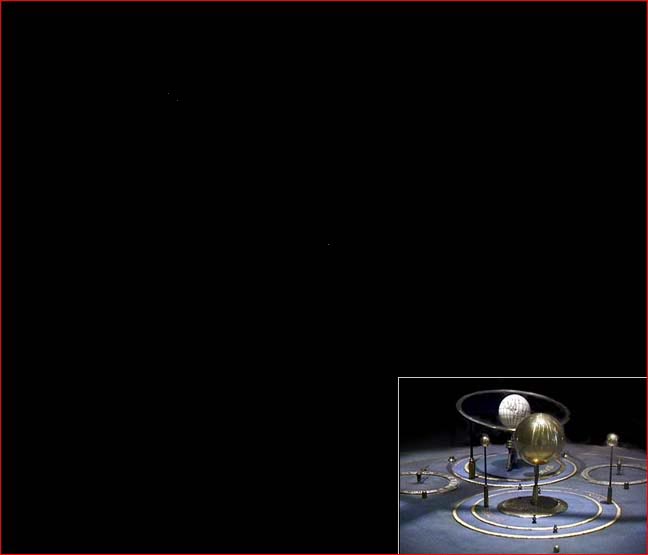
home •
about •
essential guide •
picture of the day •
thunderblogs •
news •
multimedia •
predictions •
products •
get involved •
contact

Credit: Wal Thornhill
Caption: A picture of the solar system as seen from the nearest
star. Do you see the
dust mote toward the center? That is our Sun.
Inset: An early mechanical model of
the planetary system, now in the
British Natural History Museum. The scale of the planets
is several
thousand times larger than the scale of the orbits. But at that
time people had
no need to imagine the emptiness of space.
pic of the day
archive
subject index
abstract
archive
Links:
Society for
Interdisciplinary
Studies
Jan 27, 2005
Making Sense of Emptiness
The biological origins of our senses have a great influence on what we think about the things we sense. In our everyday lives we usually compare the size of things to the size of ourselves. This "human scale" is the "default setting," as it were, in the human sensory system. The structure of this system predetermines the ways in which we organize and "make sense" of our sensations.
When we want to organize and "make sense" of our observations of planets and stars, we have to substitute something much larger than ourselves for the "unit size." But we still "make sense" of sizes by means of comparisons. And when sizes become too big to easily make sense, we simply change scales. With planets, it's often the Earth that's the "unit size:" Mars is about half the size of the Earth, Jupiter is eleven times, the Sun is 110 times. With orbits, the distance of the Earth from the Sun--the Astronomical Unit (AU)--is the unit of choice: Pluto's orbit then has a radius of 39 AU.
These two scales are not often compared. We commonly see illustrations of orbits drawn to one scale with superimposed planets drawn to another scale. Piling one scale on top of another gives us a sense that space is "full," as with the orrery shown (inset) above.
But this sense is an astronomical mistake. Now that we are sending spacecraft between planets, we need to better understand the scale of space: We need to develop a sense of emptiness. One way to do this is to make use of the coincidence that there are about as many inches in a mile as there are AUs in a light year. So if Earth is 1 inch away from the Sun, the nearest star will be 4 miles away. At this scale, Pluto will be about 3 feet away and the entire solar system would almost fit inside a person's outstretched arms.
Now at this scale the Sun would be a dust mote less than 1/100 inch across. The Earth would be microscopic at 1/100 the size of the Sun, or about a ten-thousandth of an inch across. That's about the size of a bacterium.
Imagine floating in the darkness midway between the dust motes of the Sun and the nearest star. The dust motes are a couple of miles away. You probably wouldn't perceive them. You would think the universe was empty. But this is an artifact of our biological senses and their adaptation to the perception of things that are near "our size" in our environment.
What if our senses were adapted to the perception of charged particles moving in AU-sized streams? What if we could feel the electrical forces between these streams? What if we could see the radiation they emit? What if we understood that they possess a power billions of times greater than the gravitational influence of the dust motes?
The spacecraft that we are sending into space, that require us to develop a sense of the scale of space, are fitted with technological sensors that can perceive these things.
Our picture of space is changing…
To be continued. See Jan 28, 2005 Solid Plasma
EXECUTIVE EDITORS:
David Talbott, Wallace Thornhill
MANAGING EDITOR: Amy Acheson
CONTRIBUTING EDITORS: Mel Acheson, Michael Armstrong, Dwardu Cardona,
Ev Cochrane, C.J. Ransom, Don Scott, Rens van der Sluijs, Ian Tresman
WEBMASTER: Michael Armstrong
Copyright 2005: thunderbolts.info